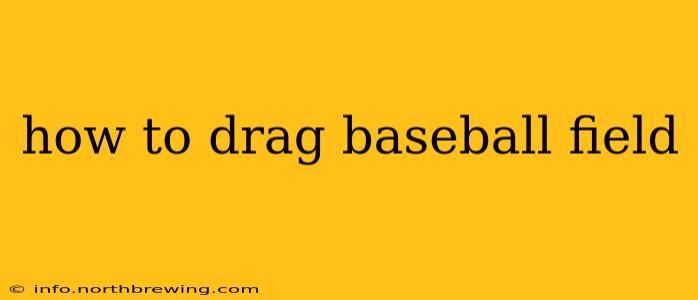How to Drag a Baseball Field: A Comprehensive Guide for Maintaining a Perfect Playing Surface
Maintaining a pristine baseball field requires consistent effort, and dragging is a crucial part of that process. This comprehensive guide will cover various aspects of dragging, ensuring you achieve a smooth, even playing surface ideal for optimal gameplay. We'll explore different tools, techniques, and considerations for various field conditions.
What is dragging, and why is it important?
Dragging a baseball field refers to the process of using specialized equipment to smooth and level the infield dirt. This is essential for several reasons:
- Improved Playability: A properly dragged field provides a consistent and predictable playing surface, leading to fairer gameplay. Ground balls will bounce more evenly, and infielders will have a better chance of making plays.
- Water Removal: Dragging helps to remove excess water from the field after rain, preventing mud and improving drainage.
- Leveling: It smooths out uneven spots and divots, creating a level playing surface free of hazards.
- Preventing Ruts: Regular dragging prevents the formation of ruts and deep grooves, which can disrupt gameplay and damage the field.
What equipment do I need to drag a baseball field?
The tools required depend on the size of your field and your budget. Here are some common options:
- Drag Mat: This is the most common tool, a large, heavy mat typically made of canvas or similar durable material. These come in various sizes and weights.
- Drag Harrow: A more robust option, the drag harrow is a metal frame with tines that cut through the dirt, providing more aggressive leveling. This is often used after heavy rain or for more significant leveling needs.
- Towing Vehicle: You'll need a vehicle like an ATV, utility vehicle, or even a tractor to tow the drag mat or harrow. The size and power of the vehicle should match the size and weight of the dragging equipment.
- Water Source: A hose is crucial, especially after dragging, to moisten the field and settle the dirt.
How to drag a baseball field: A step-by-step guide
- Assess the Field: Before you begin, assess the field’s condition. Identify areas needing the most attention, such as particularly rough patches or waterlogged sections.
- Prepare the Equipment: Ensure your drag mat or harrow is securely attached to your towing vehicle.
- Start Dragging: Begin by dragging in a consistent pattern, usually from foul line to foul line, covering the entire infield. Overlapping passes are essential to achieve a smooth surface.
- Adjust Dragging Technique: Modify your dragging technique based on the field condition. For instance, in wet conditions, use lighter passes to avoid excessive compaction.
- Water the Field: After dragging, water the field thoroughly to settle the dirt and prevent dust. This also helps to promote grass growth.
- Inspect and Repeat: Inspect the field for any remaining imperfections and repeat the process as needed.
What are some common mistakes to avoid when dragging a baseball field?
- Dragging Too Aggressively: Over-dragging can compact the soil, reducing drainage and making the field harder.
- Dragging in the Wrong Direction: Dragging against the grain of the grass can damage the turf.
- Ignoring Wet Conditions: Dragging when the field is excessively wet can cause significant damage and mud.
- Neglecting Maintenance: Inconsistent dragging can lead to the formation of ruts and uneven surfaces.
How often should I drag a baseball field?
The frequency of dragging depends on several factors, including weather conditions, usage, and soil type. Generally, it’s a good practice to drag the field after each game or practice and after significant rainfall. Regular, preventative dragging will be far more effective than trying to fix major problems after they’ve developed.
What are some alternative methods for maintaining a baseball infield?
Beyond dragging, several other techniques contribute to a well-maintained baseball field:
- Aerification: This process involves removing small plugs of soil to improve drainage and aeration.
- Topdressing: Applying a layer of fine material helps to level the field and improve the playing surface.
- Overseeding: Planting new grass seed helps to maintain a healthy and thick turf.
By following these guidelines and consistently maintaining your field, you can ensure a smooth, playable surface for all players and maximize enjoyment of the game. Remember, regular maintenance is key to preventing larger problems down the line.
